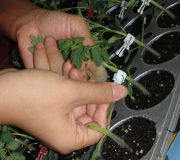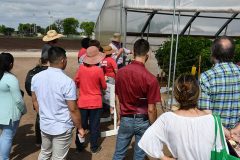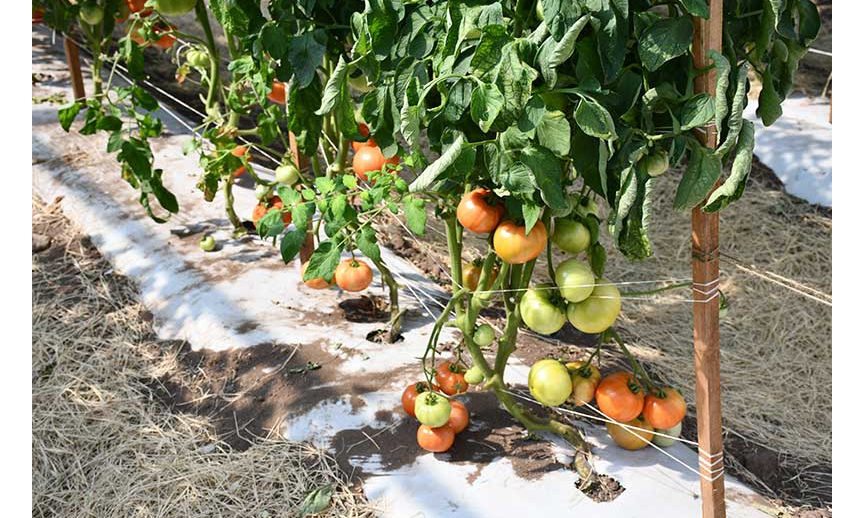A team of Texas A&M AgriLife researchers and horticulturists are investigating how successful integration of vegetable grafting into tomato production practices could present new opportunities for the Texas tomato industry.
More than 2,100 acres in Texas were used for tomato production in 2012, in 2015, that crop value reached $4.9 million, according to the USDA’s National Agricultural Statistical Service.
“When you look at the prices per hundredweight for fresh tomatoes and see that consumers are willing to pay more for high-quality produce, this presents a promising opportunity for Texas producers,” said Dr. Daniel Leskovar, plant pathologist and director of the Texas A&M AgriLife Research and Extension Center in Uvalde.
Leskovar was principal investigator for the multi-location study on tomato grafting and production systems. He and other AgriLife personnel have been investigating how producers can graft tomatoes to vigorous rootstocks to effectively manage soil diseases and abiotic stresses while improving fruit quality and yield.
Leskovar said study results demonstrate that grafting and the use of a protected environment system have the potential to significantly increase production in tomato-producing areas of Texas.
Story continues below
“The use of grafting techniques may also hold potential for the improvement of other vegetable crops grown in Texas—and for better profitability by Texas producers,” he said. “Producers have told us they are interested in diversifying their production by introducing more high-value crops that can also be grown off-season. We saw grafting as a possible way to help them meet that goal with their tomato production.”
Grafting can be used to develop more stress- and disease-resistant varieties with better fruit quality and yield.

Vegetable grafting involves the replacement of one root system with another having more desirable traits. Grafting susceptible scion varieties onto stress or disease resistant rootstocks can be an effective tool for developing certain high-value crops, said Leskovar.
For the study, tomato trials were conducted by AgriLife personnel in Uvalde, Overton, Weslaco and Lubbock to evaluate the yield performance of grafted tomatoes in protected environment and open field conditions during the spring 2017 growing season. In each location, two determined tomato cultivars Tamu Hot and Tycoon, were grafted onto two interspecific hybrid rootstocks, Estamino and Multifort. Non-grafted Tamu Hot and Tycoon tomato plants were used as controls.
The protected environment was a high-tunnel production system, or “hoop house,” which allows producers to extend their growing season, have better control over training or supporting the plants and promote better overall management of pests and nutrients.
“There is a good deal of field-grown tomato production in southern and central Texas, with the largest production occurring in climate-controlled greenhouses in West Texas,” said Leskovar. “A primary goal of this research was to discover if we could find ways producers can improve their profitability by breeding and combining tomato plants that perform well in these areas and have qualities and characteristics that will appeal to consumers.”

Field experiments were arranged in a randomized complete block design with four to five replications, depending on location.
“Yield performance of the graft combinations varied with location and production system,” Leskovar said. “In the Uvalde location, high-tunnel system production increased marketable tomato yields by 161 percent relative to a traditional open-field field growing system. There was also a 23 percent yield increase due to grafting with interspecific rootstocks.”
He said yield increase in grafted plants was mainly due to significant increases in average fruit weight, adding grafted plants are also more vigorous and have different water and nutrient requirements than non-grafted ones.
“In the Overton location, where only an open-field trial was conducted, grafting Tycoon on Estamino and Multifort significantly increased the marketable yield by 44 percent as compared to the non-grafted control,” Leskovar continued.
He said similar yield increases due to the grafting were also achieved under open-field conditions in the Weslaco location, although yield levels were generally lower than those of other locations.
Results from these studies will be presented at the annual meeting of the American Society for Horticultural Sciences in Washington D.C. in late July.
Keep reading:
https://www.theshelbyreport.com/2018/06/04/leafy-greens-food-safety-task-force/
https://www.theshelbyreport.com/2018/06/04/little-leaf-farms-expansion-devens-mass/

